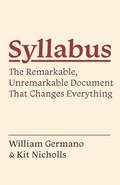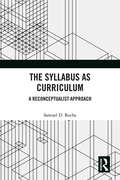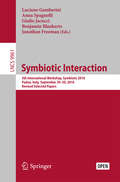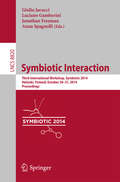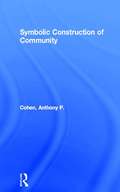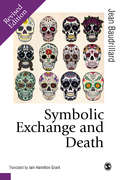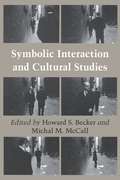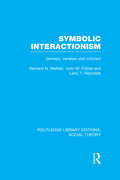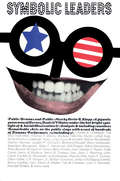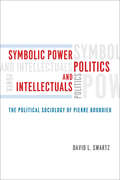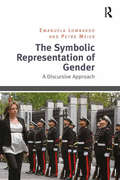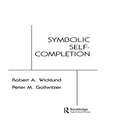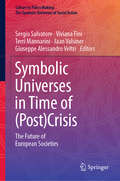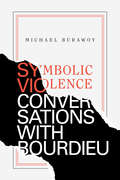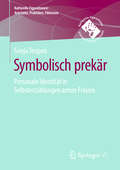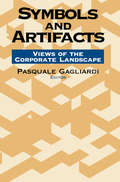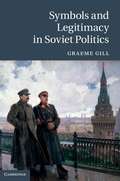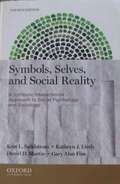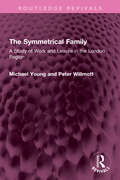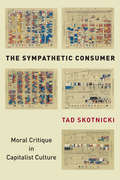- Table View
- List View
Switzerland: Selected Issues (Imf Staff Country Reports #Country Report No. 13/129)
by International Monetary Fund. European Dept.A report from the International Monetary Fund.
Syllabus: The Remarkable, Unremarkable Document That Changes Everything (Skills for Scholars)
by William Germano Kit NichollsHow redesigning your syllabus can transform your teaching, your classroom, and the way your students learnGenerations of teachers have built their classes around the course syllabus, a semester-long contract that spells out what each class meeting will focus on (readings, problem sets, case studies, experiments), and what the student has to turn in by a given date. But what does that way of thinking about the syllabus leave out—about our teaching and, more importantly, about our students’ learning?In Syllabus, William Germano and Kit Nicholls take a fresh look at this essential but almost invisible bureaucratic document and use it as a starting point for rethinking what students—and teachers—do. What if a teacher built a semester’s worth of teaching and learning backward—starting from what students need to learn to do by the end of the term, and only then selecting and arranging the material students need to study?Thinking through the lived moments of classroom engagement—what the authors call “coursetime”—becomes a way of striking a balance between improv and order. With fresh insights and concrete suggestions, Syllabus shifts the focus away from the teacher to the work and growth of students, moving the classroom closer to the genuinely collaborative learning community we all want to create.
The Syllabus as Curriculum: A Reconceptualist Approach (Routledge Research in Education)
by Samuel D. RochaCan the syllabus constitute the curriculum? In this volume, Rocha explores curriculum theory through the lens of the syllabus. By critiquing curriculum studies and the entire field of education, overrun by the social sciences, Rocha provides an integrated vision of philosophy of education and curriculum theory, rooted in the humanities. Through an original reconceptualization, this text draws from a broad range of sources – ranging from Classical Antiquity to the present – offering a rich context for understanding curriculum as a philosophically salient concept, contained within the syllabus. The Syllabus as Curriculum features actual syllabi created and taught by the author in undergraduate and graduate courses at the University of British Columbia, Canada. These curated syllabi work as exemplars and media, supported by pedagogical commentary and context. Inspired by Augustine’s Confessions, each part of the book culminates in a metaphorical "garden," which serves as a meditation on the syllabus in three senses: correspondence, essay, and outline. An original, powerful, and corrective contribution to the literature on curriculum studies, this work invites teachers and scholars from across the foundations of education, especially philosophy of education, art education, and those invested in curriculum theory, to see their contribution in more direct and integral ways.
Symbiotic Interaction
by Luciano Gamberini Anna Spagnolli Giulio Jacucci Benjamin Blankertz Jonathan FreemanThis book constitutes the proceedings of the 4th International Workshop on Symbiotic Interaction, Symbiotic 2015, held in Berlin, Germany, in October 2015. The 11 full papers and 8 short papers presented in this volume were carefully reviewed and selected from 23 submissions. The papers present an overview of the symbiotic relationships between humans and computers as well as novel advancements. The idea of symbiotic systems put forward in this workshop capitalises on the computers' ability to implicitly detect the users goals and psycho-physiological states and thereby enhancing human-computer interaction (HCI). A special focus of this year's Symbiotic Workshop will be on physiological computing approaches, e. g. using brain-computer interface (BCI) technology.
Symbiotic Interaction
by Giulio Jacucci Luciano Gamberini Jonathan Freeman Anna SpagnolliThis book constitutes the proceedings of the third International Workshop on Symbiotic Interaction, Symbiotic 2014, held in Helsinki, Finland, in October 2014. The 8 full papers and 5 short papers presented in this volume were carefully reviewed and selected from 16 submissions. They are organized in topical sections named: definitions of symbiotic interaction; reviews of implicit interaction; example applications; experimenting with users; and demos and posters.
Symbolic Construction of Community (Key Ideas)
by Anthony P. CohenAnthony Cohen makes a distinct break with earlier approaches to the study of community, which treated the subject in largely structural terms. His view is interpretive and experiential, seeing the community as a cultural field with a complex of symbols whose meanings vary among its members. He delineates a concept applicable to local and ethnic communities through which people see themselves as belonging to society. The emphasis on boundary is sensitive to the circumstances in which people become aware of the implications of belonging to a community, and describes how they symbolise and utilise these boundaries to give substance to their values and identities.
Symbolic Exchange and Death (Published in association with Theory, Culture & Society #Vol. 25)
by Professor Jean BaudrillardJean Baudrillard is one of the most celebrated and most controversial of contemporary social theorists. This major work occupies a central place in the rethinking of the humanities and social sciences around the idea of postmodernism. It leads the reader on an exhilarating tour encompassing the end of Marxism, the enchantment of fashion, symbolism about sex and the body, and the relations between economic exchange and death. Most significantly, the book represents Baudrillard's fullest elaboration of the concept of the three orders of the simulacra, defining the historical passage from production to reproduction to simulation. A classic in its field, Symbolic Exchange and Death is a key source for the redefinition of contemporary social thought. Baudrillard's critical gaze appraises social theories as diverse as cybernetics, ethnography, psychoanalysis, feminism, Marxism, communications theory and semiotics. This English translation begins with a new introductory essay.
Symbolic Exchange and Death (Published in association with Theory, Culture & Society #Vol. 25)
by Professor Jean BaudrillardJean Baudrillard is one of the most celebrated and most controversial of contemporary social theorists. This major work occupies a central place in the rethinking of the humanities and social sciences around the idea of postmodernism. It leads the reader on an exhilarating tour encompassing the end of Marxism, the enchantment of fashion, symbolism about sex and the body, and the relations between economic exchange and death. Most significantly, the book represents Baudrillard's fullest elaboration of the concept of the three orders of the simulacra, defining the historical passage from production to reproduction to simulation. A classic in its field, Symbolic Exchange and Death is a key source for the redefinition of contemporary social thought. Baudrillard's critical gaze appraises social theories as diverse as cybernetics, ethnography, psychoanalysis, feminism, Marxism, communications theory and semiotics. This English translation begins with a new introductory essay.
Symbolic Interaction and Cultural Studies
by Becker, Howard S. and McCall, Michal M.Symbolic interactionism, resolutely empirical in practice, shares theoretical concerns with cultural studies and humanistic discourse. Recognizing that the humanities have engaged many of the important intellectual currents of the last twenty-five years in ways that sociology has not, the contributors to this volume fully acknowledge that the boundary between the social sciences and the humanities has begun to dissolve. This challenging volume explores that border area.
Symbolic Interaction and Cultural Studies
by Becker, Howard S. and McCall, Michal M.Symbolic interactionism, resolutely empirical in practice, shares theoretical concerns with cultural studies and humanistic discourse. Recognizing that the humanities have engaged many of the important intellectual currents of the last twenty-five years in ways that sociology has not, the contributors to this volume fully acknowledge that the boundary between the social sciences and the humanities has begun to dissolve. This challenging volume explores that border area.
Symbolic Interactionism: Genesis, Varieties and Criticism (Routledge Library Editions: Social Theory Ser.)
by Bernard Meltzer John Petras Larry ReynoldsSymbolic interactionsim is of major importance in contemporary sociology. In this study, three authorities in the field collaborate to define symbolic interactionism and to describe, and present criticism of, the interactionist perspective. The contributions of G.H. Mead, J. Dewey, C.H. Cooley, W.I. Thomas and other theorists to the interactionist viewpoint on human behaviour and social life are examined. There is a systematic discussion of the diverse schools of thought within the field, including H.G. Blumer’s Chicago School, M.H. Kuhn’s Iowa School, E. Goffman’s dramaturgical approach and H. Garfinkel’s ethnomethodology. Criticisms of symbolic interactionism by both adherents and opponents to the perspective are selected and assessed. Throughout the book, the authors survey the social and intellectual sources of significant ideas, thereby incorporating a reflexive, sociology-of-sociology orientation.
Symbolic Leaders: Public Dramas and Public Men
by Orrin E. KlappRadio, television and the press form the vast stage on which the public dramas of our time are played to a responsive audience of millions- the peoples of our nation and of the world. Almost anyone can steal the scene and become a public hero, a favorite villain or a lamented victim. How do these persons-the symbolic leaders-emerge? Who are they? How does the climate of public opinion affect the would-be leader? How does the public use its leaders?This book discusses how symbolic leaders emerge, how unknown people become symbolic and it analyzes the kinds of encounters that are likely to make individuals either ""heroes,"" ""villains,"" or ""fools."" The book portrays the ups-and-downs of public images, as well as crises and role reversals, in which parties may swap roles without meaning to. The book concludes with a final chapter, which deals with the concept of public drama and its implications for change as well as its instability in modern society.Symbolic Leaders is a probing and provocative analysis of the process of public drama and of the actors, who play the leading roles, discussed in terms of their significance for the structures of our rapidly changing society and illustrated by vivid case histories. Professor Klapp's lively style makes this work an eminently readable sociological study. The social scientist will find in it a challenging and original theory of social organization, which suggests strategic areas for further research. Public relations personnel will find it an invaluable practical handbook of clues for creating a public image. And the general reader will find Symbolic Leaders a fascinating and thought-provoking commentary on public life in our society.
Symbolic Power, Politics, and Intellectuals: The Political Sociology of Pierre Bourdieu
by David SwartzPower is the central organizing principle of all social life, from culture and education to stratification and taste. And there is no more prominent name in the analysis of power than that of noted sociologist Pierre Bourdieu. Throughout his career, Bourdieu challenged the commonly held view that symbolic power--the power to dominate--is solely symbolic. He emphasized that symbolic power helps create and maintain social hierarchies, which form the very bedrock of political life. By the time of his death in 2002, Bourdieu had become a leading public intellectual, and his argument about the more subtle and influential ways that cultural resources and symbolic categories prevail in power arrangements and practices had gained broad recognition. In Symbolic Power, Politics, and Intellectuals, David L. Swartz delves deeply into Bourdieu's work to show how central--but often overlooked--power and politics are to an understanding of sociology. Arguing that power and politics stand at the core of Bourdieu's sociology, Swartz illuminates Bourdieu's political project for the social sciences, as well as Bourdieu's own political activism, explaining how sociology is not just science but also a crucial form of political engagement.
The Symbolic Representation of Gender: A Discursive Approach
by Emanuela Lombardo Petra MeierWhat is symbolic representation? Since Hanna Pitkin’s seminal The Concept of Representation, the symbolic has been the least studied dimension of political representation. Innovatively adopting a discursive approach, this book - the first full-length treatment of symbolic representation - focuses on gender issues to tackle important questions such as: What are women and men symbols of, and how is gender constructed in policy discourse? It studies what functions symbolic representation fulfils in the construction of gender, what social roles get legitimized in policy discourse, and how this affects power constellations, ultimately revealing much about the relation between symbolic, descriptive, and substantive representation. Emanuela Lombardo and Petra Meier draw on theories of symbolic representation and gender, as well as rich primary material about political debates on labour and care issues, partnership and reproductive rights, gender violence, and quotas. Using this original data, the authors show that reconsidering symbolic representation from a discursive perspective makes explicit issues of (in)equality embedded within particular constructions, as well as their consequences for political representation and gender equality. This important exploration raises relevant new questions regarding the representation of gender that form valuable contributions to the fields of political science, political theory, sociology, and gender studies.
Symbolic Self Completion
by R. A. Wicklund P. M. GollwitzerFirst published in 1982. Routledge is an imprint of Taylor & Francis, an informa company.
Symbolic Universes in Time of: The Future of European Societies (Culture in Policy Making: The Symbolic Universes of Social Action)
by Sergio Salvatore Viviana Fini Terri Mannarini Jaan Valsiner Giuseppe Alessandro VeltriThis book investigates whether, how and where the cultural milieu of European societies has changed as a result of the socio-economics crisis. To do so, it adopts a psycho-cultural approach, which views the cultural milieu as a set of meanings, placing the generalized image social actors have of themselves, the world, events and their relationships in the context of the socio-political and institutional environment, including policies. By analyzing the changes in cultural milieu and social identity, the book develops strategic and methodological guidelines for the design of post-crisis policies, providing a concept of how the cultural dynamics are associated with certain individual characteristics and specific socio-economic phenomena.
Symbolic Violence: Conversations with Bourdieu
by Michael BurawoyIn Symbolic Violence Michael Burawoy brings Pierre Bourdieu into an extended debate with Marxism—a tradition Bourdieu ostensibly avoided. While Bourdieu's expansive body of work stands as a critique of Marx's inadequate account of cultural domination, Burawoy shows how Bourdieu's eschewal and rejection of Marxism led him to miss out on a number of productive theoretical engagements. In eleven &“conversations,&” Burawoy outlines the intellectual and biographical parallels and divergences between Bourdieu and the work of preeminent Marxist thinkers. Among many topics, Burawoy examines Bourdieu's appropriation and silencing of Beauvoir and her theory of masculine domination; the commonalities as well as differences in Bourdieu's and Fanon's thought on colonialism and revolution; the extent to which Gramsci's theory of hegemony aligns with Bourdieu's notion of symbolic violence; and both how Freire and Bourdieu understood education as the site of oppression. In showing how Bourdieu has more in common with these thinkers than Bourdieu himself cared to admit, Burawoy offers a critical assessment of Bourdieu's work that illuminates its paradoxes and reaffirms its significance for the twenty-first century.
Symbolisch prekär: Personale Identität in Selbsterzählungen armer Frauen (Kulturelle Figurationen: Artefakte, Praktiken, Fiktionen)
by Sonja TeupenIm Zentrum der mikrosoziologisch und kulturpsychologisch informierten Studie steht die Subjektposition der armen Frau. Im Unterschied zu anderen Subjektpositionen geht diese nicht mit einem Versprechen sozialer Anerkennung einher, sondern erfolgt vorrangig unter Bedingungen symbolischer Prekarität. Anhand von Selbsterzählungen von Frauen in Armutslagen in Deutschland und den USA wird untersucht, wie die Erzählerinnen ihr Subjektsein narrativ verhandeln und damit personale Identität konstituieren. Die Analyse im methodologischen Rahmen der relationalen Hermeneutik rekonstruiert zwei Ebenen des Gegenstandes: Thematisch plausibilisieren die Erzählerinnen ihr Armsein entlang der Topoi Krankheit, Trennung, Kindheit und Schicksal. Strukturell sind ihre Erzählungen aufgespannt zwischen den Punkten Widerfahrnis und Handlung, Identifikation und Differenz, Zurechnung und Autonomie.Der InhaltEinführungSozial- und kulturwissenschaftliche Identitätsforschung im interpretativen ParadigmaPersonale IdentitätMethodik der Analyse personaler IdentitätFallvergleich und Typisierung: AnalyseTopik und Typologie: DiskussionSchlussDie AutorinDr. Sonja Teupen ist Wissenschaftliche Mitarbeiterin für Qualitative Methoden am Deutschen Zentrum für Neurodegenerative Erkrankungen (DZNE), Standort Witten. Im Kontext der Demenz-Versorgungsforschung arbeitet sie unter anderem zum Thema Selbst und Personsein in sozialen Beziehungen. Daneben ist sie Lehrbeauftragte des Instituts für Soziologie an der FernUniversität in Hagen.
Symbolische Ordnung und Flüchtlingsbewegungen in der Einwanderungsgesellschaft
by Emre Arslan Kemal BozayDas Thema der Flüchtlingsbewegungen ist in den letzten Jahren vielfach in den Fokus politischer, medialer und wissenschaftlicher Diskurse gerückt. Dabei geht es sowohl um eine globale Diskussion über die Fluchtthematik als solches als auch um die Lebensbedingungen von geflüchteten Menschen in der Aufnahmegesellschaft. Gegenwärtig kann beobachtet werden, dass die Willkommensstimmung gegenüber Geflüchteten größtenteils gekippt ist, und in der politischen, institutionellen und medialen Debatte über Geflüchtete eine Tendenz zur Kriminalisierung und Skandalisierung vorherrscht. Vielfältige aktuelle Forschungen haben sich interdisziplinär mit den unterschiedlichen Aspekten der Flüchtlingsbewegungen beschäftigt. Dieser Sammelband hat sich zum Ziel gesetzt, den Bourdieuschen Diskurs zur „Symbolischen Ordnung“ auf das Themenfeld „Flüchtlingsbewegungen“ zu übertragen und zu diskutieren.
The Symbolism of Globalization, Development, and Aging
by John W. Murphy Steven L. ArxerThis book looks at the symbolic side of globalization, development, and aging. Many of the dimensions that are discussed represent updates of past debates but some are entirely new. In particular, globalization is accompanied by subtle social imagery that profoundly shapes the way institutions and identities are imagined. The process of aging and persons sense of identity is no exception. The underlying assumptions that pervade globalization inform how critical dimensions of aging are discussed and institutionalized. The application of marketplace imagery, for example, may impact attempts for holism in how aging is studied and the prospects for human agency during the aging process. This book offers a special look into how temporality, technology, normativity, and empiricism structure the symbolic side of globalization and influence dominant images of the aging process. Current debates about globalization and aging are expanded by helping readers see the social imagery that is both subtly behind globalization and at the forefront of shaping the aging experience.
Symbols and Artifacts: Views of the Corporate Landscape
by Pasquale GagliardiA selection of 18 papers from an international conference in Milan, June 1987, organized by the Standing Conference on Organizational Symbolism. Details how corporate artifacts are invested with meaning, are related to control, and can be used as cultural indicators in research. Among the topics are office design, housing modifications, computer systems, and the space shuttle. Fairly devoid of specialist jargon.
Symbols and Legitimacy in Soviet Politics
by Graeme GillSymbols and Legitimacy in Soviet Politics analyses the way in which Soviet symbolism and ritual changed from the regime's birth in 1917 to its fall in 1991. Graeme Gill focuses on the symbolism in party policy and leaders' speeches, artwork and political posters, and urban redevelopment, and on ritual in the political system. He shows how this symbolism and ritual were worked into a dominant metanarrative which underpinned Soviet political development. Gill also shows how, in each of these spheres, the images changed both over the life of the regime and during particular stages: the Leninist era metanarrative differed from that of the Stalin period, which differed from that of the Khrushchev and Brezhnev periods, which was, in turn, changed significantly under Gorbachev. In charting this development, the book lays bare the dynamics of the Soviet regime and a major reason for its fall.
Symbols, Selves, and Social Reality: A Symbolic Interactionist Approach to Social Psychology and Sociology
by Kent L. Sandstrom Kathryn J. Lively Daniel D. Martin Gary Alan FineThe fourth edition of Symbols, Selves, and Social Reality provides students with a succinct, engaging, and affordable introduction to symbolic interactionism--the perspective that social reality is created, negotiated, and changed through the process of social interaction. Focusing on how elements of race and gender affect identity, the authors use real-world examples to discuss the personal significance of symbolic interactionism, its expanding theoretical scope, and its relationship to other prominent perspectives in sociology and social psychology. They skillfully cover empirical research topics that are inherently interesting to students, such as the dynamics of self-development, impression management, identity transformation, gender play, rumor transmission, and collective action.
The Symmetrical Family: A Study of Work and Leisure in the London Region (Routledge Revivals)
by Michael Young Peter WillmottFirst published in 1973, The Symmetrical Family combines evidence about the family of the past with information from a sociological survey in the London region and uses both as the basis for a speculative discussion about the future. The argument is that a new style of family life has emerged. Its basis is not equality between husbands and wives but at least something approaching symmetry: increasingly wives work outside the home and husbands inside it. The new family is itself under increasing pressure. Contrary to the popular view, there is yet no sign of a general increase in leisure. In some occupations work is dominant and becoming more so; at the same time the proportions of people in such jobs, though still in the minority, are expanding. The growing demand of wives for paid work outside the home means that in place of two jobs, one for the husband and one for the wife, there will often be four, with both working inside as well as outside the home. How long will people be able to bear the consequent strain? In a final chapter the authors discuss what they think will happen unless people decide quite deliberately, to reduce the pressure upon themselves and their children. This book will be of interest to students of sociology, health, social care, anthropology and public policy.
The Sympathetic Consumer: Moral Critique in Capitalist Culture (Culture and Economic Life)
by Tad SkotnickiWhen people encounter consumer goods—sugar, clothes, phones—they find little to no information about their origins. The goods will thus remain anonymous, and the labor that went into making them, the supply chain through which they traveled, will remain obscured. In this book, Tad Skotnicki argues that this encounter is an endemic feature of capitalist societies, and one with which consumers have struggled for centuries in the form of activist movements constructed around what he calls The Sympathetic Consumer. This book documents the uncanny similarities shared by such movements over the course of three centuries: the transatlantic abolitionist movement, US and English consumer movements around the turn of the twentieth century, and contemporary Fair Trade activism. Offering a comparative historical study of consumer activism the book shows, in vivid detail, how activists wrestled with the broader implications of commodity exchange. These activists arrived at a common understanding of the relationship between consumers, producers, and commodities, and concluded that consumers were responsible for sympathizing with invisible laborers. Ultimately, Skotnicki provides a framework to identify a capitalist culture by examining how people interpret everyday phenomena essential to it.

